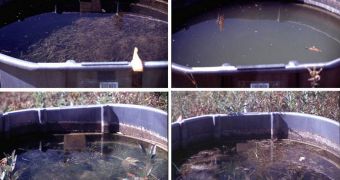Studying biodiversity is never simple, mainly because of its intrinsic complexity. Researchers have for many years attempted to study them in experimental setups that tried to make things possible, but always failed. The errors were not fundamental, but the end results were always skewed, and a group of experts now believes it knows why. The scientists have just finished running a 7-year experiment with artificial, small-scale ponds. They wanted to see how biodiversity evolves, and what are its main driving factors, Details of the work are published online in this week's issue of the respected journal Science Express, the US National Science Foundation (NSF) reports.
“We would try to duplicate pond communities with a given experimental treatment. We put 10 of this species in each pond, and five of these species, and eight of the other species, and 15 milliliters of this nutrient and 5 grams of that and 'sproing,' every replicate would do its own thing and nothing would be like anything else. That made me curious. What if, instead of trying to eliminate the messiness, I tried to figure out where it was coming from?” says Washington University in St. Louis (WUSL) ecologist and scientist Jon Chase.
“This study is an important experimental confirmation of the influence of primary productivity on regional biodiversity. The findings have broader relevance to the protection and restoration of biodiversity,” says the NSF Division of Environmental Biology program director, Alan Tessier. The DEB provided the WUSL team with funding for their investigation. Chase's main conclusion following the study was that pond communities (plants and animals alike) evolve depending on which species are introduced first. This is vital knowledge for those seeking to return ecosystems such as coral reefs and rain forests to their former glory and biodiversity.
The experiments began in 2002, when about 45 cattle tanks, each filled with 300 gallons of water, were placed on a field. All of them received varying concentrations of nutrients (low, medium or high) and the same number of species. But the trick was that a number of species was being added each year, with the order in which they were placed in the tanks varying from one to the next. “Then we let nature take over. The plankton moved around in the wind and on frogs' backs, dragonflies flitted over and laid their eggs, beetles buzzed by, and it was a 'big happy wetland community',” Chase says.

 14 DAY TRIAL //
14 DAY TRIAL //